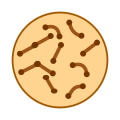Corynebacterium diphtheriae is the pathogenic bacterium that causes diphtheria. It is also known as the Klebs-Löffler bacillus, because it was discovered in 1884 by German bacteriologists Edwin Klebs (1834 â€" 1912) and Friedrich Löffler (1852 â€" 1915).
Classification

Four subspecies are recognized: C. d. mitis, C. d. intermedius, C. d. gravis, and C. d. belfanti. The four subspecies differ slightly in their colonial morphology and biochemical properties, such as the ability to metabolize certain nutrients, but all may be toxigenic (and therefore cause diphtheria) or not toxigenic. C. diphtheriae produces diphtheria toxin which alters protein function in the host by inactivating the elongation factor EF-2. This causes pharyngitis and 'pseudomembrane' in the throat. The diphtheria toxin gene is encoded by a bacteriophage found in toxigenic strains, integrated into the bacterial chromosome.
To accurately identify C. diphtheriae, a Gram stain is performed to show Gram-positive, highly pleomorphic organisms with no particular arrangement. Special stains like Alberts's stain and Ponder's stain are used to demonstrate the metachromatic granules formed in the polar regions. The granules are called as polar granules, Babes Ernst granules, volutin, etc. An enrichment medium, such as Löffler's medium, is used to preferentially grow C. diptheriae. After that, a differential plate known as tellurite agar, allows all Corynebacteria (including C. diphtheriae) to reduce tellurite to metallic tellurium. The tellurite reduction is colormetrically indicated by brown colonies for most Cornyebacteria species or by a black halo around the C. diphtheriae colonies.
A low concentration of iron is required in the medium for toxin production. At high iron concentrations, iron molecules bind to an aporepressor on the beta bacteriophage, which carries the Tox gene. When bound to iron, the aporepressor shuts down toxin production. Elek's test for toxogenicity is used to determine whether the organism is able to produce the diphtheria toxin.
Pathogenesis

In areas where diptheria is endemic, C. diptheriae in the nasopharyngeal passageways is common. Toxigenic strains in susceptible individuals can cause disease by multiplying and secreting diptheria toxin into either skin or nasopharyngeal lesions. The diptheritic lesion is often covered by a pseudomembrane composed of fibrin, bacteria, and inflammatory cells. Diphtheria toxin can be proteolytically cleaved into two fragments: an N-terminal fragment A (catalytic domain), and fragment B (transmembrane and receptor binding domain). Fragment A catalyzes the NAD+ -dependent ADP-ribosylation of elongation factor 2, thereby inhibiting protein synthesis in eukaryotic cells. Fragment B binds to the cell surface receptor and facilitates the delivery of fragment A to the cytosol.
Sensitivity

The bacterium is sensitive to the majority of antibiotics, such as the penicillins, ampicillin, cephalosporins, quinolones, chloramphenicol, tetracyclines, cefuroxime, and trimethoprim.
Genetics

The genome of C. diphtheriae consists of a single circular chromosome of 2,5 Mbp, with no plasmids. The genome shows an extreme compositional bias, being noticeably higher in G+C near the origin than at the terminus.
